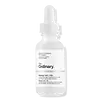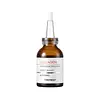What's inside
What's inside
 Key Ingredients
Key Ingredients

 Benefits
Benefits

 Concerns
Concerns

No concerns
 Ingredients Side-by-side
Ingredients Side-by-side

Water
Skin ConditioningGlycerin
HumectantButylene Glycol
HumectantPalmitoyl Tripeptide-1
Skin ConditioningPalmitoyl Tetrapeptide-7
Skin ConditioningPalmitoyl Tripeptide-38
Skin ConditioningSodium Hyaluronate
HumectantHydroxypropyl Cyclodextrin
MaskingPPG-26-Buteth-26
Skin ConditioningPEG-40 Hydrogenated Castor Oil
EmulsifyingPolyacrylate Crosspolymer-6
Emulsion StabilisingTrisodium Ethylenediamine Disuccinate
Carbomer
Emulsion StabilisingPolysorbate 20
EmulsifyingEthoxydiglycol
HumectantPhenoxyethanol
PreservativeChlorphenesin
AntimicrobialWater, Glycerin, Butylene Glycol, Palmitoyl Tripeptide-1, Palmitoyl Tetrapeptide-7, Palmitoyl Tripeptide-38, Sodium Hyaluronate, Hydroxypropyl Cyclodextrin, PPG-26-Buteth-26, PEG-40 Hydrogenated Castor Oil, Polyacrylate Crosspolymer-6, Trisodium Ethylenediamine Disuccinate, Carbomer, Polysorbate 20, Ethoxydiglycol, Phenoxyethanol, Chlorphenesin
Water
Skin ConditioningChondrus Crispus Powder
AbrasivePentylene Glycol
Skin ConditioningHippophae Rhamnoides Oil
EmollientGellan Gum
Ceramide NP
Skin ConditioningOlea Europaea Fruit Oil
MaskingSodium Citrate
BufferingRosa Canina Fruit Oil 10%
EmollientPolyglycerin-3
HumectantPrunus Amygdalus Dulcis Oil
Skin ConditioningGlycerin
HumectantHydrogenated Lecithin
EmulsifyingSodium Hyaluronate
HumectantGlycosphingolipids
EmollientCetyl Ethylhexanoate
EmollientPropanediol
SolventAmmonium Acryloyldimethyltaurate/Beheneth-25 Methacrylate Crosspolymer
Emulsion StabilisingStyrene/Vp Copolymer
Hydrolyzed Sodium Hyaluronate
Skin ConditioningAdenosine
Skin ConditioningGlyceryl Stearate
EmollientXanthan Gum
EmulsifyingAgar
MaskingMacadamia Integrifolia Seed Oil
Skin ConditioningDiethoxyethyl Succinate
SolventAcrylates/C10-30 Alkyl Acrylate Crosspolymer
Emulsion StabilisingButylene Glycol
Humectant1,2-Hexanediol
Skin ConditioningSoluble Collagen
HumectantMethyl Gluceth-20
HumectantTocopherol
AntioxidantDisodium EDTA
Caprylic/Capric Triglyceride
MaskingGlyceryl Acrylate/Acrylic Acid Copolymer
HumectantTromethamine
BufferingDipropylene Glycol
HumectantWater, Chondrus Crispus Powder, Pentylene Glycol, Hippophae Rhamnoides Oil, Gellan Gum, Ceramide NP, Olea Europaea Fruit Oil, Sodium Citrate, Rosa Canina Fruit Oil 10%, Polyglycerin-3, Prunus Amygdalus Dulcis Oil, Glycerin, Hydrogenated Lecithin, Sodium Hyaluronate, Glycosphingolipids, Cetyl Ethylhexanoate, Propanediol, Ammonium Acryloyldimethyltaurate/Beheneth-25 Methacrylate Crosspolymer, Styrene/Vp Copolymer, Hydrolyzed Sodium Hyaluronate, Adenosine, Glyceryl Stearate, Xanthan Gum, Agar, Macadamia Integrifolia Seed Oil, Diethoxyethyl Succinate, Acrylates/C10-30 Alkyl Acrylate Crosspolymer, Butylene Glycol, 1,2-Hexanediol, Soluble Collagen, Methyl Gluceth-20, Tocopherol, Disodium EDTA, Caprylic/Capric Triglyceride, Glyceryl Acrylate/Acrylic Acid Copolymer, Tromethamine, Dipropylene Glycol
 Reviews
Reviews

Ingredients Explained
These ingredients are found in both products.
Ingredients higher up in an ingredient list are typically present in a larger amount.
Butylene Glycol (or BG) is used within cosmetic products for a few different reasons:
Overall, Butylene Glycol is a safe and well-rounded ingredient that works well with other ingredients.
Though this ingredient works well with most skin types, some people with sensitive skin may experience a reaction such as allergic rashes, closed comedones, or itchiness.
Learn more about Butylene GlycolGlycerin is already naturally found in your skin. It helps moisturize and protect your skin.
A study from 2016 found glycerin to be more effective as a humectant than AHAs and hyaluronic acid.
As a humectant, it helps the skin stay hydrated by pulling moisture to your skin. The low molecular weight of glycerin allows it to pull moisture into the deeper layers of your skin.
Hydrated skin improves your skin barrier; Your skin barrier helps protect against irritants and bacteria.
Glycerin has also been found to have antimicrobial and antiviral properties. Due to these properties, glycerin is often used in wound and burn treatments.
In cosmetics, glycerin is usually derived from plants such as soybean or palm. However, it can also be sourced from animals, such as tallow or animal fat.
This ingredient is organic, colorless, odorless, and non-toxic.
Glycerin is the name for this ingredient in American English. British English uses Glycerol/Glycerine.
Learn more about GlycerinSodium Hyaluronate is hyaluronic acid's salt form. It is commonly derived from the sodium salt of hyaluronic acid.
Like hyaluronic acid, it is great at holding water and acts as a humectant. This makes it a great skin hydrating ingredient.
Sodium Hyaluronate is naturally occurring in our bodies and is mostly found in eye fluid and joints.
These are some other common types of Hyaluronic Acid:
Learn more about Sodium HyaluronateWater. It's the most common cosmetic ingredient of all. You'll usually see it at the top of ingredient lists, meaning that it makes up the largest part of the product.
So why is it so popular? Water most often acts as a solvent - this means that it helps dissolve other ingredients into the formulation.
You'll also recognize water as that liquid we all need to stay alive. If you see this, drink a glass of water. Stay hydrated!
Learn more about Water